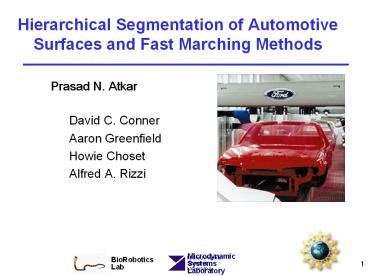Hierarchical Segmentation of Automotive Surfaces and Fast Marching Methods PowerPoint PPT Presentation
Title: Hierarchical Segmentation of Automotive Surfaces and Fast Marching Methods
1
Hierarchical Segmentation of Automotive Surfaces
and Fast Marching Methods
Prasad N. Atkar
- David C. Conner
- Aaron Greenfield
- Howie Choset
- Alfred A. Rizzi
Microdynamic Systems Laboratory
BioRobotics Lab
2
Automated Trajectory Generation
- Generate trajectories on curved surfaces for
material removal/deposition - Maximize uniformity
- Minimize cycle time and material waste
Spray Painting
CNC Milling
Bone Shaving
3
Challenges
Deposition Pattern
- Complex deposition patterns
- Non-Euclidean surfaces
- High dimensioned search-space for optimization
Warping of the Deposition Pattern
Target Surface
4
Related Research
- Index Optimization
- Simplified surface with simplified deposition
patterns (Suh et.al, Sheng et.al, Sahir and
Balkan, Asakawa and Takeuchi) - Speed Optimization
- Global optimization (Antonio and Ramabhadran, Kim
and Sarma)
5
Overview of Our Approach
- Divide the problem into smaller sub-problems
- Understand the relationships between the
parameters and output characteristics - Develop rules to reduce problem dimensionality
- Solve each sub-problem independently
Dimensionality Reduction
Model Based Planning
Simulation
Constraints
Path Variables
Output Characteristics
Rule Based Planning
System Parameters
Output
6
Our Approach Decomposition
- Segment surface into cells
- Topologically simple/monotonic
- Low surface curvature
- Generate passes in each cell
Repeat offsetting and speed optimization
Select start curve
Optimize index width and generate offset curve
Optimize end effector speed
7
Rules for Trajectory generation
Avoid painting holes (cycle time, paint waste)
Select passes with minimal geodesic curvature
(uniformity)
Minimize number of turns (cycle time, paint
waste)
8
Choice of Start Curve
- Select a geodesic curve
- Select spatial orientation (minimizing number of
turns) - Select relative position with respect to boundary
(minimizing geodesic curvature)
9
Effect of Surface Curvature
- Offsets of geodesics are not geodesics in
general!! - Geodesic curvature of passes depends on surface
curvature - Gauss-Bonnet Theorem
10
Selecting position of Start Curve
- Select start curve as a geodesic Gaussian
curvature divider
11
Speed and Index Optimization
- Speed optimization
- Minimize variation in paint profiles along the
direction of passes - Index optimization
- Minimize variation in paint deposition along
direction orthogonal to the passes
12
Offset Pass Generation (Implementation)
- Marker points
- Self-intersections difficulty
- Topological changes
Initial front
Front at a later instance
Marker pt. soln.
Images from http//www.imm.dtu.dk/mbs/downloads/l
evelset040401.pdf
13
Level Set Method Sethian
- Assume each front at is a zero level set of an
evolving function of zF(x,t) - Solve the PDE (H-J eqn)
given the initial front F(x,t0)
http//www.imm.dtu.dk/mbs/downloads/levelset04040
1.pdf
14
Fast Marching Method Sethian
- F(x,t)0 is single valued in t if F preserves
sign - T(x) is the time when front crosses x
- H-J Equation reduces to simpler Eikonal equation
?
T0
given
T3
- Using efficient sorting and causality, compute
T(x) at all x quickly.
15
FMM Similarity with Dijkstra
- Similar to Dijkstras algorithm
- Wavefront expansion
- O(N logN) for N grid points
- Improves accuracy by first order approximation to
distance
16
FMM Contd.
8
1
8
1
Dijkstra
FMM
First order approximation
For 2-D grid
In our example,
17
FMM on triangulated manifolds
- Evaluate finite difference on a triangulated
domain - Basis two linearly independent vectors
C
5
5
4
2
B
A
Front grad.
T(A)10
T(B) 8
Dijkstra T(C)min(T(A)5, T(B)5)13
FMM T(C)8412
18
Hierarchical Surface Segmentation
- Segment surface into cells
- Advantages
- Improves paint uniformity, cycle time and paint
waste - Requirements
- Low Geodesic curvature of passes
- Topological monotonicity of the passes
19
Geometrical Segmentation
- To improve uniformity of paint deposition
- Minimize Geodesic curvature of passes
- Restrict the regions of high Gaussian curvature
to boundaries
20
Geometrical Segmentation
- Watershed Segmentation on RMS curvature of the
surface - Maxima of RMS sqrt((k12k22)/2) Maxima of
Gaussian curvature k1k2 - Four Steps
- Minima detection
- Minima expansion
- Descent to minima
- Merging based on Watershed Height
http//cmm.ensmp.fr/beucher/wtshed.html
21
Topological Segmentation
- Improves paint waste and cycle time by avoiding
holes - Orientation of slices
- Planar Surfaces (cycle time minimizing)
- Extruded Surfaces (based on principal curvatures)
- Surfaces with non-zero curvature (maximally
orthogonal section plane)
22
Pass Based Segmentation
- Improves cycle time and paint waste associated
with overspray - Segment out narrow regions
- Generate slices at discrete intervals
23
Region Merging
- Merge Criterion
- Minimize sum of lengths of boundaries reduce
boundary ill-effects on uniformity - Merge as many cells as possible such that each
resultant cell is - Geometrically simple
- Inspect boundaries
- Topologically monotonic (single connected
component of the offset curve, and spray gun
enters and leaves a given cell exactly once) - Partition directed connectivity graph such that
each subgraph is a trail
24
Region Merging Results
Segmented
Merged
Segmented
Merged
Segmented
Merged
25
Summary
- Rules to reduce dimensionality of the optimal
coverage problem - Gauss-Bonnet theorem to select the start curve
- Fast marching methods to offset passes
- Hierarchical Segmentation of Surfaces
26
Future WorkCell Stitching
- Optimize ordering in which cells are painted
- Optimize overspray to minimize the cross-boundary
deposition - Optimize end effector velocity
27
Thank You!Questions?

